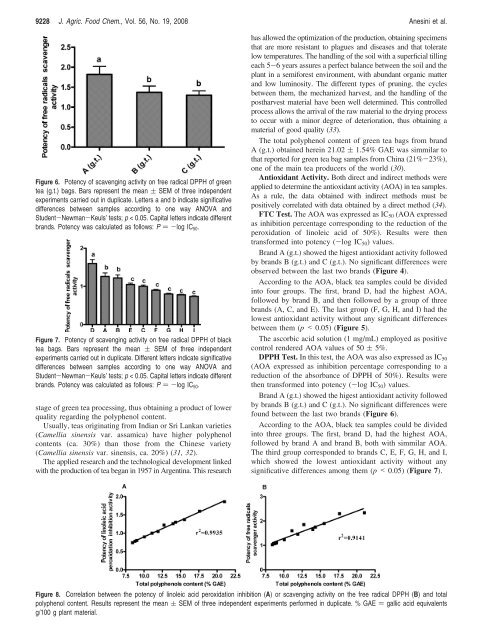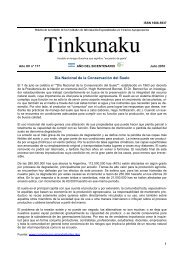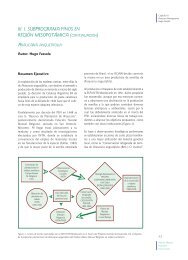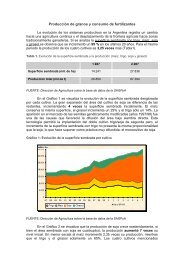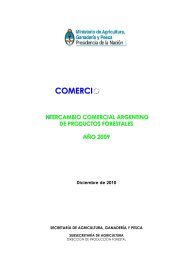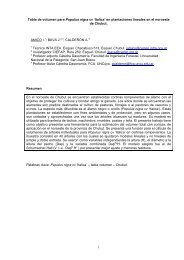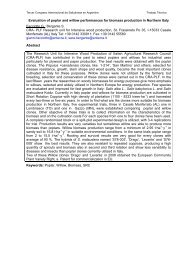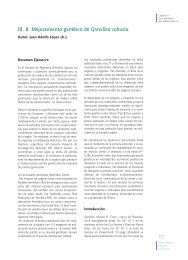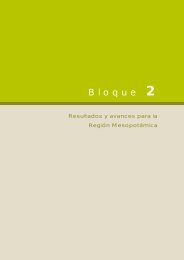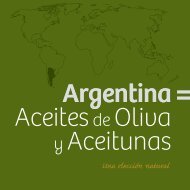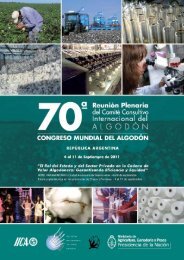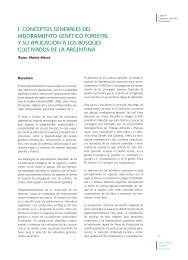9228 J. Agric. Food Chem., Vol. 56, No. 19, 2008 Anesini et al.Figure 6. Potency <strong>of</strong> scavenging activity on free radical DPPH <strong>of</strong> greentea (g.t.) bags. Bars represent the mean ( SEM <strong>of</strong> three independentexperiments carried out in duplicate. Letters a <strong>and</strong> b indicate significativedifferences between samples according to one way ANOVA <strong>and</strong>Student-Newman-Keuls’ tests; p < 0.05. Capital letters indicate differentbr<strong>and</strong>s. Potency was calculated as follows: P )-log IC 50 .Figure 7. Potency <strong>of</strong> scavenging activity on free radical DPPH <strong>of</strong> blacktea bags. Bars represent the mean ( SEM <strong>of</strong> three independentexperiments carried out in duplicate. Different letters indicate significativedifferences between samples according to one way ANOVA <strong>and</strong>Student-Newman-Keuls’ tests; p < 0.05. Capital letters indicate differentbr<strong>and</strong>s. Potency was calculated as follows: P )-log IC 50 .stage <strong>of</strong> green tea processing, thus obtaining a product <strong>of</strong> lowerquality regarding the polyphenol content.Usually, teas originating from Indian or Sri Lankan varieties(Camellia sinensis var. assamica) have higher polyphenolcontents (ca. 30%) than those from the Chinese variety(Camellia sinensis var. sinensis, ca. 20%) (31, 32).The applied research <strong>and</strong> the technological development linkedwith the production <strong>of</strong> tea began in 1957 in Argentina. This researchhas allowed the optimization <strong>of</strong> the production, obtaining specimensthat are more resistant to plagues <strong>and</strong> diseases <strong>and</strong> that toleratelow temperatures. The h<strong>and</strong>ling <strong>of</strong> the soil with a superficial tillingeach 5-6 years assures a perfect balance between the soil <strong>and</strong> theplant in a semiforest environment, with abundant organic matter<strong>and</strong> low luminosity. The different types <strong>of</strong> pruning, the cyclesbetween them, the mechanized harvest, <strong>and</strong> the h<strong>and</strong>ling <strong>of</strong> thepostharvest material have been well determined. This controlledprocess allows the arrival <strong>of</strong> the raw material to the drying processto occur with a minor degree <strong>of</strong> deterioration, thus obtaining amaterial <strong>of</strong> good quality (33).The total polyphenol content <strong>of</strong> green tea bags from br<strong>and</strong>A (g.t.) obtained herein 21.02 ( 1.54% GAE was simmilar tothat reported for green tea bag samples from China (21%-23%),one <strong>of</strong> the main tea producers <strong>of</strong> the world (30).<strong>Antioxidant</strong> Activity. Both direct <strong>and</strong> indirect methods wereapplied to determine the antioxidant activity (AOA) in tea samples.As a rule, the data obtained with indirect methods must bepositively correlated with data obtained by a direct method (34).FTC Test. The AOA was expressed as IC 50 (AOA expressedas inhibition percentage corresponding to the reduction <strong>of</strong> theperoxidation <strong>of</strong> linoleic acid <strong>of</strong> 50%). Results were thentransformed into potency (-log IC 50 ) values.Br<strong>and</strong> A (g.t.) showed the higest antioxidant activity followedby br<strong>and</strong>s B (g.t.) <strong>and</strong> C (g.t.). No significant differences wereobserved between the last two br<strong>and</strong>s (Figure 4).According to the AOA, black tea samples could be dividedinto four groups. The first, br<strong>and</strong> D, had the highest AOA,followed by br<strong>and</strong> B, <strong>and</strong> then followed by a group <strong>of</strong> threebr<strong>and</strong>s (A, C, <strong>and</strong> E). The last group (F, G, H, <strong>and</strong> I) had thelowest antioxidant activity without any significant differencesbetween them (p < 0.05) (Figure 5).The ascorbic acid solution (1 mg/mL) employed as positivecontrol rendered AOA values <strong>of</strong> 50 ( 5%.DPPH Test. In this test, the AOA was also expressed as IC 50(AOA expressed as inhibition percentage corresponding to areduction <strong>of</strong> the absorbance <strong>of</strong> DPPH <strong>of</strong> 50%). Results werethen transformed into potency (-log IC 50 ) values.Br<strong>and</strong> A (g.t.) showed the higest antioxidant activity followedby br<strong>and</strong>s B (g.t.) <strong>and</strong> C (g.t.). No significant differences werefound between the last two br<strong>and</strong>s (Figure 6).According to the AOA, black tea samples could be dividedinto three groups. The first, br<strong>and</strong> D, had the highest AOA,followed by br<strong>and</strong> A <strong>and</strong> br<strong>and</strong> B, both with simmilar AOA.The third group corresponded to br<strong>and</strong>s C, E, F, G, H, <strong>and</strong> I,which showed the lowest antioxidant activity without anysignificative differences among them (p < 0.05) (Figure 7).Figure 8. Correlation between the potency <strong>of</strong> linoleic acid peroxidation inhibition (A) or scavenging activity on the free radical DPPH (B) <strong>and</strong> totalpolyphenol content. Results represent the mean ( SEM <strong>of</strong> three independent experiments performed in duplicate. % GAE ) gallic acid equivalentsg/100 g plant material.
<strong>Total</strong> <strong>Polyphenol</strong> <strong>Content</strong> <strong>and</strong> <strong>Antioxidant</strong> <strong>Capacity</strong> <strong>of</strong> Tea J. Agric. Food Chem., Vol. 56, No. 19, 2008 9229The ascorbic acid solutions employed as positive control at thefollowing concentrations 0.1 µg/mL; 1.0 µg/mL; 10 µg/mL; 100µg/mL; <strong>and</strong> 1.000 µg/mL rendered AOA values <strong>of</strong> 0; 6.3 ( 0.5%;63.6 ( 5.0%; 74.0 ( 5.0%; <strong>and</strong> 83.3 ( 7.0%, respectively.Correlation between the <strong>Antioxidant</strong> <strong>Capacity</strong> <strong>and</strong> the<strong>Total</strong> <strong>Polyphenol</strong> <strong>Content</strong>. Numerous examples <strong>of</strong> the application<strong>of</strong> the Folin-Ciocalteu assay to characterize naturalproducts may be found in the literature. In most cases, totalphenols determined by this method are correlated with theantioxidant capacities confirming the value <strong>of</strong> the Folin-Ciocalteutest (34). A new enzymatic method involoving the use <strong>of</strong>horseradish peroxidase <strong>and</strong> 4-aminoantipyrine has recently beenused in a comparative study <strong>of</strong> total polyphenol content <strong>of</strong> tea.Significant differences were found in the results obtained bythe Folin-Ciocalteu <strong>and</strong> enzimatic methods indicating that theenzymatic method needs further st<strong>and</strong>ardization (35).In this work, a high correlation was demonstrated betweenthe total polyphenol content <strong>and</strong> antioxidant capacities by bothmethods. Pearson’s correlation coefficients (r 2 ) were 0.9935 <strong>and</strong>0.9141 for the FTC <strong>and</strong> DPPH assays, respectively (Figure 8A,B).The total polyphenol content <strong>and</strong> the antioxidant activity areboth parameters <strong>of</strong> quality for tea regarding its biologicalproperties, <strong>and</strong> both assays should be applied for the qualitycontrol <strong>of</strong> manufactured <strong>and</strong> imported teas. According to theresults obtained, tea from Argentina is <strong>of</strong> very good quality incomparison to tea from other sources. This is the first systematicsurvey <strong>of</strong> teas from the Argentine market.LITERATURE CITED(1) Muktar, H.; Ahmad, N. Tea polyphenols: prevention <strong>of</strong> cancer<strong>and</strong> optimizing health. Am. J. Clin. Nutr. 2000, 71, 1698S–1702S.(2) Graham, H. N. Tea. In Wiley Encyclopedia <strong>of</strong> Food Science <strong>and</strong>Technology, 2nd ed.; Frederick, J. F., Ed.; John Wiley & Sons:New York, 1999; Vol. 1-4, pp 2292-2305.(3) Carr, M. K. V. The climatic requirements <strong>of</strong> the tea plant: Areview. Exp. Agric. 1972, 8, 1–14.(4) Carr, M. K. V.; Stephens, W. Climate, Weather <strong>and</strong> the Yield <strong>of</strong>Tea. In Tea: CultiVation to Consumption; Willson, K. C., Clifford,M. N., Eds.; Chapman & Hall: London, 1992; pp 87-135.(5) De Costa, W.A.J.M.; Mohotti, A. J.; Wijeratine, M. A. Ecophysiology<strong>of</strong> tea. Braz. J. Plant Physiol 2007, 19 (4), 299–332.(6) Parra, P. Té. (Camellia sinensis L.). ReVista Alimentos Argentinos(Buenos Aires) 2006, 34, 18-26.(7) Lee, K. W.; Lee, H. J.; Lee, C. Y. <strong>Antioxidant</strong> activity <strong>of</strong> blacktea vs. green tea. J. Nutr. 2002, 132, 785.(8) Dufresne, C. J.; Farnworth, E. R. A review <strong>of</strong> latest researchfindings on the health promotion properties <strong>of</strong> tea. J. Nutr.Biochem. 2001, 12, 404–421.(9) Frei, B.; Higdon, J. V. <strong>Antioxidant</strong> activity <strong>of</strong> tea polyphenols in vivo:evidence from animal studies. J. Nutr. 2003, 133, 3275S–3284S.(10) Wiseman, S. A.; Balentine, D. A.; Frei, B. <strong>Antioxidant</strong>s in tea.Crit. ReV. Food Sci. Nutr. 1997, 37, 705–708.(11) Zhong, Z.; Connor, H. D.; Froh, M.; Bunzendahl, H.; Lind, H.;Lehnert, M.; Mason, R. P.; Thurman, R. G.; Lemasters, J. J. Freeradical-dependent dysfunction <strong>of</strong> small-for-size rat liver grafts:prevention by plant polyphenols. Gastroenterology 2005, 129,652–664.(12) Rietveld, A.; Wiseman, S. <strong>Antioxidant</strong> effects <strong>of</strong> tea: evidencefrom human clinical trials. J. Nutr. 2003, 133, 3285S–3292S.(13) Cai, Y. J.; Ma, L. P.; Hou, L. F.; Zhou, B.; Yang, L.; Liu, Z. L.<strong>Antioxidant</strong> effects <strong>of</strong> green tea polyphenols on free radicalinitiated peroxidation <strong>of</strong> rat liver microsomes. Chem. Phys. Lipids.2002, 120, 109–117.(14) Higdon, J. V.; Frei, B. Tea catechins <strong>and</strong> polyphenols: healtheffects, metabolism, <strong>and</strong> antioxidant functions. Crit. ReV. FoodSci. Nutr. 2003, 43 (1), 89–143.(15) Yang, T. T.; Koo, M. W. Chinese green tea lowers cholesterollevel through an increase in fecal lipid excretion. Life Sci. 2000,66 (5), 411–423.(16) Chyu, K. Y.; Babbidge, S. M.; Zhao, X.; D<strong>and</strong>illaya, R.; Rietveld,A. G.; Yano, J.; Dimayuga, P.; Cercek, B.; Shah, P. K. Differentialeffects <strong>of</strong> green tea-derived catechin on developing versusestablished atherosclerosis in apolipoprotein E-null mice. Circulation2004, 109 (20), 2448–2453.(17) Yang, C. S.; Maliakal, P.; Meng, X. Inhibition <strong>of</strong> carcinogenesisby tea. Annu. ReV. Pharmacol. Toxicol. 2002, 42, 25–54.(18) Khan, N.; Mukhtar, H. Tea polyphenols for health promotion.Life Sci. 2007, 81, 519–533.(19) Dona, M.; Dell’Aica, I.; Calabrese, F.; Benelli, R.; Morini, M.;Albini, A.; Garbisa, S. Neutrophil restraint by green tea: inhibition<strong>of</strong> inflammation, associated angiogenesis, <strong>and</strong> pulmonary fibrosis.J. Immunol. 2003, 170 (8), 4335–4341.(20) M<strong>and</strong>el, S.; Youdim, M. B. Catechin polyphenols: neurodegeneration<strong>and</strong> neuroprotection in neurodegenerative diseases. FreeRadical Biol. Med. 2004, 37 (3), 304–317.(21) Ob<strong>and</strong>a, M.; Owuor, P. O.; Taylor, S. J. Flavanol composition<strong>and</strong> caffeine content <strong>of</strong> green leaf as quality potential indicators<strong>of</strong> Kenyan black teas. J. Sci. Food Agric. 1997, 74, 209–215.(22) ISO 14502-1: 2005. Determination <strong>of</strong> substances characteristic<strong>of</strong> green <strong>and</strong> blck tea. Part 1: <strong>Content</strong> <strong>of</strong> total polyphenols in tea.Colorimetric method using Folin-Ciocalteu reagent.(23) Osawa, T.; Namiki, M. A novel type <strong>of</strong> antioxidant isolated fromleaf wax <strong>of</strong> Eucalyptus leaves. Agric. Biol. Chem. 1981, 45, 735–740.(24) Alex<strong>and</strong>er, B.; Browse, D. J.; Reading, S. J.; Benjamin, I. S. Asimple <strong>and</strong> accurate mathematical methods for calculation <strong>of</strong> theEC 50. J. Pharmacol. Toxicol. 1999, 41, 55–58.(25) Blois, M. S. <strong>Antioxidant</strong> determinations by the use <strong>of</strong> a stablefree radical. Nature. 1958, 26, 1199–1200.(26) Singleton, V. L.; Orth<strong>of</strong>er, R.; Lamuela-Raventós, R. M. Analysis<strong>of</strong> total phenols <strong>and</strong> other oxidation substrates <strong>and</strong> antioxidantsby means <strong>of</strong> Folin-Ciocalteu reagent. Method Enzymol. 1999,299, 152–178.(27) Cloughley, J. B. Storage deterioration in Central African tea: theeffect <strong>of</strong> some production variables on theaflavin degradation. J.Sci. Food Agric. 1981, 32, 1229–1234.(28) Hara, Y.; Luo, S. J.; Wickremasinghe, R. L.; Yamanishi, T. Specialissue on tea. Food ReV. Int. 1995, 11, 371–545.(29) Chan, E. W. C.; Lim, Y. Y.; Chew, Y. L. <strong>Antioxidant</strong> activity <strong>of</strong>Camellia sinensis leaves <strong>and</strong> tea from a lowl<strong>and</strong> plantation inMalaysia. Food Chem. 2007, 102 (4), 1214–1222.(30) Yao, L. H.; Jiang, Y. M.; Caffin, N.; D’Arcy, B.; Datta, N.; Liu,X.; Singanusong, R.; Xu, Y. Phenolic compounds in tea fromAustralian supermarkets. Food Chem. 2006, 96 (4), 614–620.(31) Hara, Y.; Luo, S. L.; Wickremasinghe, R. L.; Yamanishi, T.Special issue on tea. Food ReV. Int. 1995, 11, 371–545.(32) Harbowy, M. E.; Balentine, D. A. Tea chemistry. Crit. ReV. PlantSci. 1997, 16, 415–480.(33) De Bernardi, L. A. Cadenas Alimentarias: Té (Camellia sinensis).ReVista Alimentos Argentinos (Buenos Aires) 2004, 26, 17–20.(34) Roginsky, V.; Lissi, E. A. Review <strong>of</strong> methods to determine chainbreakingantioxidant activity in food. Food Chem. 2005, 92, 235–254.(35) Chen, H.; Ho, C. T. Comparative Study on <strong>Total</strong> <strong>Polyphenol</strong><strong>Content</strong> <strong>and</strong> <strong>Total</strong> <strong>Antioxidant</strong> Activity <strong>of</strong> Tea (Camellia sinensis).In <strong>Antioxidant</strong> Measurement <strong>and</strong> Applications; ACS SymposiumSeries 956; American Chemical Society: Washington, DC, 2007;pp 195-214.Received for review April 28, 2008. Accepted August 4, 2008. This workwas supported by grants from the University <strong>of</strong> Buenos Aires (B090)<strong>and</strong> from The Consejo Nacional de Investigaciones Científicas yTécnicas (CONICET) (PIP 5232), Buenos Aires, Argentina.JF8022782


